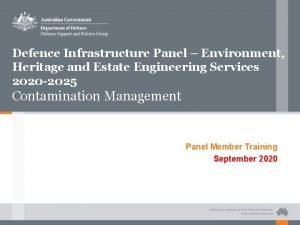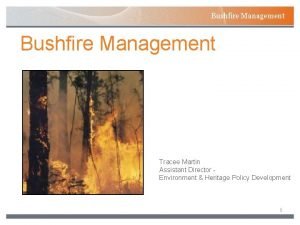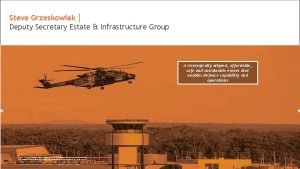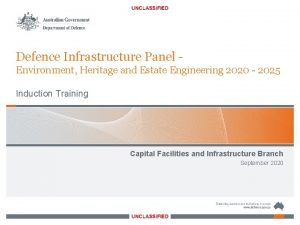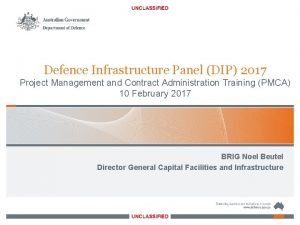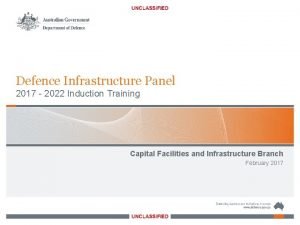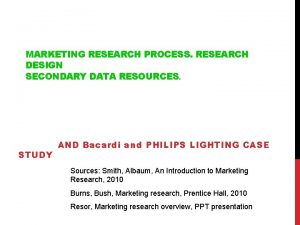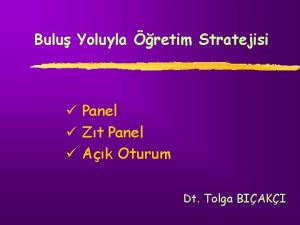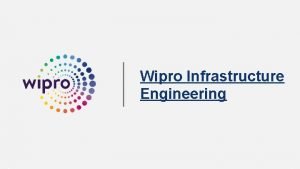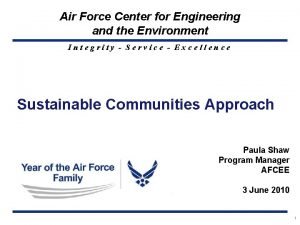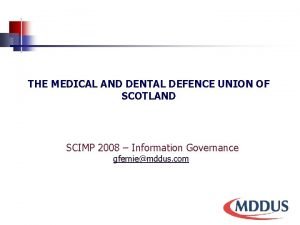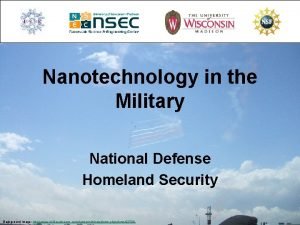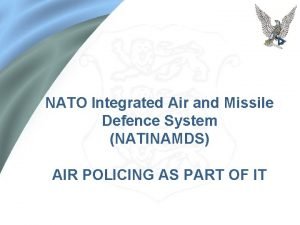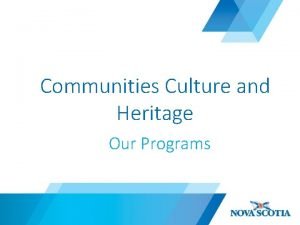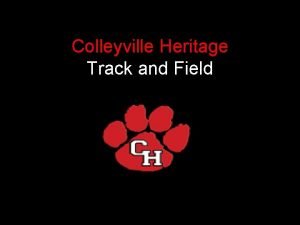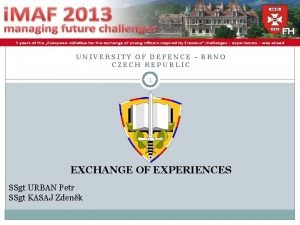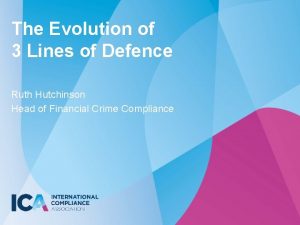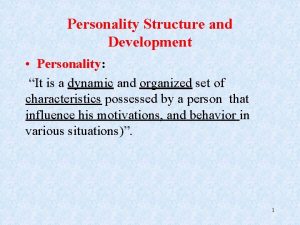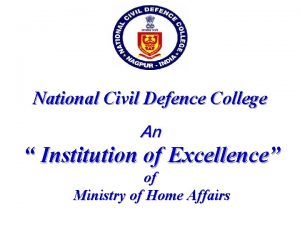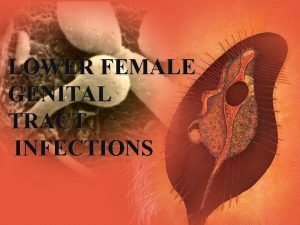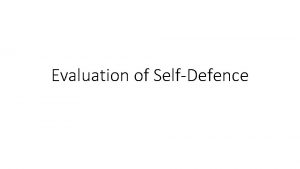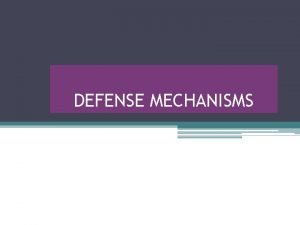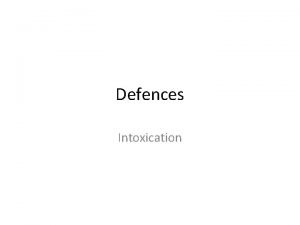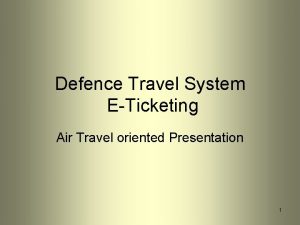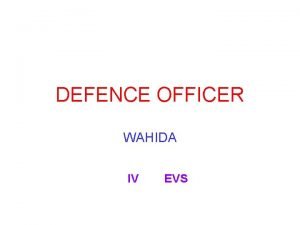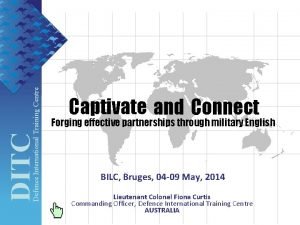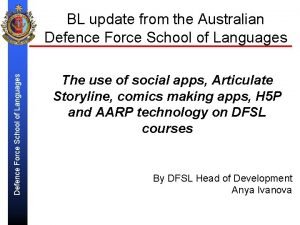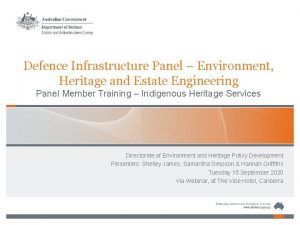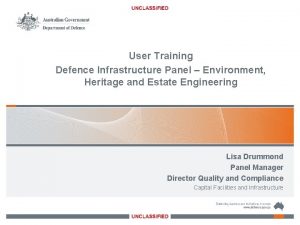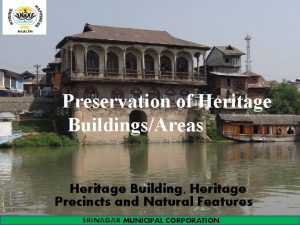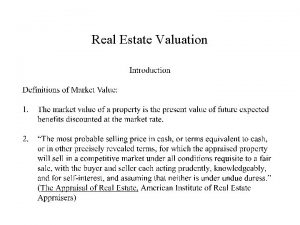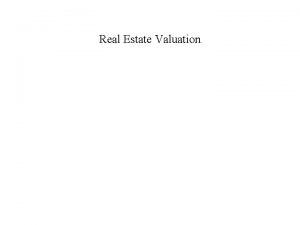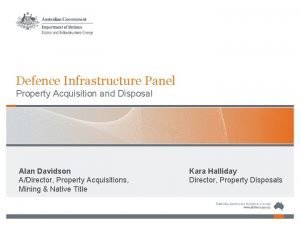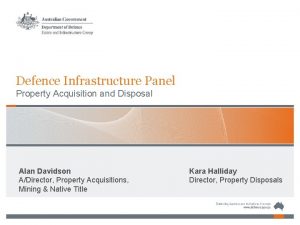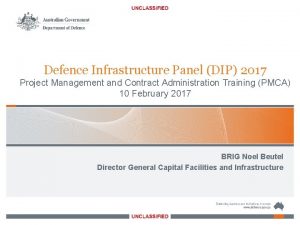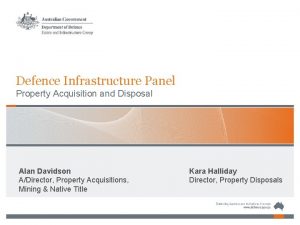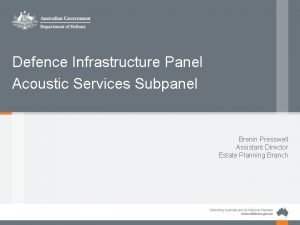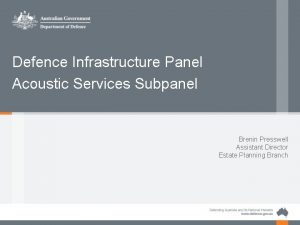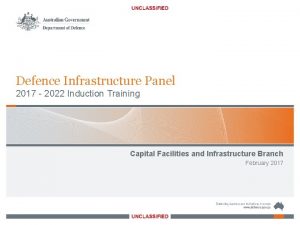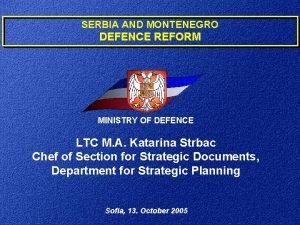Defence Infrastructure Panel Environment Heritage and Estate Engineering















































- Slides: 47

Defence Infrastructure Panel – Environment, Heritage and Estate Engineering Services 2020 -2025 Contamination Management Panel Member Training September 2020

Overview Contamination in Defence Contamination Data Regional Contamination Investigation Program (RCIP) Wartime Remnants Clean-up Program (WRCP)

DCARM Conventional Contamination – ROLE IN DEFENCE • Identify / assess/ prioritise contaminated sites – programmed according to risk • 4 major Programs • Analyse sampling data and plan future programs • Maintain contaminated site records on GEMS; sampling data on ESdat; visualisation tool (Webmap) and spatial data • Develop and maintain policy and internal guidelines • Provide technical advice to stakeholders to assist planning on the estate and interpretation of results for decision makers • Research program

DCARM Director Dr Mark Bowman RCIP NUXOP RCIP Program Manager Helen Searle NUXOP Program Manager Brian Barkworth Project Manager Karen Hansen Project Manager Natalie Sawczyn Project Manager Amethyst Lupingna Project Manager Peter Gell Project Manager TBA Program Manager TBA On-Estate Project Manager Peter Weingaertner On-Estate Project Support Marc Mc. Gowan Governance Project Manager TBA WRCP Policy & Research PR & FPD Lead Helen Horn PSI Lead Michelle Heinze Policy Support Officer Fiona Sinnett-Smith Data Manager Steve Rowe Project Manager Kieran Shields Project Manager Carina Daly Governance Project Support TBA Off-Estate Project Manager TBA Communications TBA DSI Lead Rob Kolano Project/Warehouse Manager Brigita Osolnik Technical Director Tye Boyd Technical Director Katrina Rope Directorate of Contamination Assessment, Remediation and Management PMO Support TBA

DELIVERY STRUCTURE • Infrastructure Division (ID) via EEGIS – National / Regional • Service Delivery Division (SDD) – Product Directors and Zones – how they fit in

WHAT IS CONVENTIONAL CONTAMINATION • Contaminants – – – – – Acids (low p. H number) Acid Sulphate Soils (ASS) Asbestos – in soil Explosive Residues EOW (Explosive Ordnance Waste) Fill Material Petroleum Hydrocarbons Chlorinated Hydrocarbons PFAS (currently managed by PFASIM) – Polycyclic Aromatic Hydrocarbons (PAHs) – Solvents – Metals – Nutrients – Paints / Sealants – Pesticides – PCBs (polychlorinated biphenyl) – Radioactive Materials – Waste (general landfill)

NOT CONVENTIONAL? ? • Special cases – UXO – Asbestos in buildings – Chemical Agents

WHERE TO FIND INFORMATION • DEQMS – Defence Estate Quality Management System – one stop shop for Defence – http: //www. defence. gov. au/estatemanagement/ • Also contains Defence contamination policies and directives www. defence. gov. au/environment/ then click on ‘Contamination’ • Project Delivery flowcharts and instructions outlining how projects are undertaken within Defence

CONTAMINATION HOME PAGE

PROJECT DELIVERY • Contamination Management Sequence (Swimlanes)

CONTAMINATION RISK • Risk-based approach to undertaking work • Risk matrix used to determine the agreed risk level • Risk assigned at a site level and ‘flows’ up to property level • A Contamination Risk Assessment must be undertaken whenever updates to Contaminated Site Records are provided

CONTAMINATION RISK ASSESSMENT TOOL Risk Assessment Matrix Consequence Rating Likelihood Rating Severe Major Moderate Minor Negligible 1 6 11 16 21 Almost Certain 1 Very High 2 Very High 7 High 12 Medium 17 Low 22 Likely 3 Very High 4 High 9 Medium 14 Medium 19 Low 24 Possible 5 High 6 High 11 Medium 16 Medium 21 Low 26 Unlikely 7 High 8 Medium 13 Medium 18 Low 23 Low 28 Rare 9 High 10 Medium 15 Low 20 Low 25 Low 30 Risk Dimensions

CONTAMINATION RISK ASSESSMENT TOOL

Data Contamination Data

DCMM Annex L Guidance on Data Management includes: • GEMS Contaminated Sites Records (GEMS CSR) • Environmental Data Management Software (ESdat) • Contamination Risk Assessment Tool (CRAT) • National Spatial Information Management System (NSIMS) • Sample Naming Convention Question about data management can be sent to ncrp@defence. gov. au

CONTAMINATED SITES REGISTER (CSR) within GEMS • Garrison Estate Management System (GEMS) – Central register of contamination issues on Defence owned or leased land – 2500 contaminated site records (CSRs) listed across 700 properties – Only as accurate as the updates we receive – Known Contamination Liabilities • ANAO requirement

GEMS Database – Geospatial (GEO. e)

GEMS Database – Contaminated Sites Module

GEMS Database - GDL

Environmental Data Management System - ESdat

ESdat Process

ESdat Process

Web Map

Web Map

Regional Contamination Investigation Program (RCIP)

The Regional Contamination Investigation Program 20 YEAR PROGRAM The Regional Contamination Investigation Program (RCIP) is a national, phased 20 -year program to assess, manage and reduce contamination at 700 Defence properties, across two million hectares. The Directorate of Contamination Assessment, Remediation and Management (DCARM) oversees the Program. In 2017, DCARM appointed environmental consultancies, AECOM and GHD, to undertake the first threeyear phase, which was completed in June 2020.

The rules guiding the Program Defence Contamination Management Manual: framework and technical guide for estate identification, assessment, management and remediation of contaminated land groundwater. Available in DEQMS: http: //intranet. defence. gov. au/estatemanag ement/Governance/Policy/Environment/Co ntamination/Default. asp Environment Protection and Biodiversity Conservation Act 1999 (EPBC): the Australian Government’s main environmental protection legislation. National Environment Protection Council (NEPC) National Environment Protection Measures (NEPM): National guidance for assessing site contamination. PFAS National Environmental Management Plan: national guidance for the environmental regulation of PFAS. Workplace Health and Safety Act 2011: framework to safeguard worker health and safety. The Defence WHS Manual sets out protocols for handling potentially contaminated material on estate.

Continuing Investigations The next three-year phase will begin in January 2021, with a budget of up to $30 million. The core goals for the Program are: Find and fill data gaps Quantify risks and liabilities Map contamination to inform development, management, monitoring, property disposals, and land use. Prioritise and plan contamination management and remediation.

Continuing Investigations The emphasis going forward will be on: anticipating future remediation completing Estate-wide data validation targeting high CSR frequency sites working with stakeholders to optimize DCARM activities

Next steps – what will happen in Phase Two Program Elements 1. Region 1 – Vic / Tas / Riverina 2. Region 2 – Coastal NSW / ACT 3. Region 3 – WA / NT / SA 4. Region 4 – Queensland / Nth NSW 5. Technical Advisors – Multi-Region 6. Technical Support 7. GEMS Data Maintenance Region 3 4 Queensland North NSW Region South NSW Victoria Region 1 Tasmania 2 Sydney Region & ACT

Next steps – what will happen in Phase Two Program Procurement Schedule 1. Region 1 – Vic / Tas / Riverina 2. Region 2 – Coastal NSW / ACT Sept-Nov 2020 3. Region 3 – WA / NT / SA 4. Region 4 – Queensland / Nth NSW 5. Technical Advisor/s – Multi-Region 6. Technical Support 7. GEMS Data Maintenance Nov 2020 -Jan 2021

Key RCIP Messages Jurisdictions • Please ensure you have a team, or access to a team, in each jurisdiction where work will be required. • TAs: State auditor accreditation in each jurisdiction where work will be required. Data • Do not underestimate the volume of data processing required. Get to know Annex L requirements and ensure you have staff that can deliver all data elements. • Consider efficient methods of data collection, transfer and tracking that minimize transcription errors and remain compatible with Defence systems.

Wartime Remnants Clean-up Program (WRCP)

Wartime Remnants Cleanup Program (WRCP) What is WRCP? • The Wartime Remnants Clean-up Program (WRCP) is a Defence initiative to address a well-documented but largely unknown part of Australia’s 20 th century history.

Wartime Remnants Cleanup Program (WRCP) Why WRCP? • Australia and its allies brought chemical agents to Australia during World War II to prepare for suspected chemical warfare. During and after the war, Defence disposed of these munitions and the source chemical agents on mainland Defence sites and offshore locations, using the disposal practices of the time. Over time, not all of these locations have remained on or part of the Defence estate, and some remnants remain in various locations around the country. • The presence of these agents and munitions in Australia during World War II was secret for many years. Service personnel could not disclose the important work they had done. Between then and now, land use has changed and local knowledge of these events diminished, although military history archives and publications are publicly available.

Wartime Remnants Cleanup Program (WRCP) Current WRCP? • Defence is bringing together a team of experts to undertake the WRCP including DSTG and a team of civilian experts of the US Army Chemical Biological Application and Risk Reduction (CBARR) Business Unit. The CBARR team have been working with Defence in Australia for almost 10 years, including the Columboola (QLD) and Defence Site Maribyrnong (VIC) Remediation Projects.

Wartime Remnants Cleanup Program (WRCP) Coming up • The WRCP Team will work with site owners, residents, communities and local and state authorities: – To collaborate with local stakeholders and communities to develop and deliver optimum public safety and environmental results. – To respectfully acknowledge the past efforts of our dedicated World War II service personnel. • Engage Lead Consultants to undertake: – Substantial Package Works 1 (2020 – 2023) NT and QLD (currently open) – Detailed Site Investigation – NT to start 2021 for delivery 2023 – Other support roles including Technical Advisor (Auditor), Technical Support

Research and Policy • Develop policies, standards and guidance for contamination management. Coordinate, educate and provide advice on the implementation of policy within Defence. • Liaison with C’wlth, State, Industry and Foreign militaries/agencies on policy matters. • Priorities: Guidance on soil reuse on the Defence Estate Re write if Annex C to the DCMM (Stockpiling) Re write of ASBINS Chapter of the Defence AMP Integration of NRF into policy Planning for future emerging contaminants Research • Oversee the current CRC CARE Defence Contamination Research Program. • Priorities: Delivery of CRC Projects Development of future Research Strategy

PROJECT DELIVERY What we are looking for: • High quality deliverables • Realistic project schedules – Contingencies for project slippage – Meet the agreed schedule • Stand Down – Christmas/New Year (6 weeks? ) – Typically you may not gain access to areas – Plan ahead with us, the Region and the Base • Communicate

PROJECT DELIVERABLES - REPORTING Provide Your Opinion! • QA/QC – Technically sound, defensible, objective, consistent • Key parts of the report – Executive Summary, Conclusions and Recommendations • Recommendations including costs – Remediation and/or management – considered opinion – Feasible for Defence (keeping in mind Defence capability, reputation, priorities and budget) • GIS update this reference and link – Update the spatial maps – Spatial Data Management Plan (SDMP) Section 12, Appendix C http: //www. defence. gov. au/estatemanagement. htm • CSR in GEMS – Updated with each project. (Update form – Excel Spreadsheet) • Photos – To be provided within the report and in the deliverables data pack

COMMUNICATION • Consult with us (not the regulators) – We want good working relationships with regulatory agencies – We will meet with regulatory agencies to agree on approach being taken by Defence for management of existing contamination, as required • Consider the audience – write appropriately – Keep in mind the reports will be made available to the public

STANDARDS • Relevant / Appropriate (update this section) – MDH (International) – NEPM (National) – NSW Service Station (State) • Laboratory Analysis – You must use NATA accredited labs • Research Analysis – Defence works in collaboration with CRC CARE – CRC CARE is not NATA accredited, BUT – Refine existing and develop new techniques for identification, sampling, analysis and remediation strategies (known / emerging contaminants) – Collaborative approach with Industry

VALUE ADDING • Make sure you meet the scope requirements • Offer something more as an option (if appropriate) • Think outside the box – Consider what the RFQTS might really mean and provide options and answers • Demonstrate how you are going the extra step

TECHNICAL ISSUES – WHAT’S EMERGING? • Legislation – Commonwealth / State legislative differences • EPBC obligations vs complying with the intent of State legislation, where appropriate • The challenges are compounded by how State legislation requirements interact with Commonwealth activities (both on and off Commonwealth land) • Legacy contamination – Unknown: Contaminants/ locations / impacts • Technology – Keeping pace / GEMS

CHALLENGES AHEAD • Funding – Uncertainty – Expensive – Competing priorities • Legacy Practices – Unknowns – locations / Unique chemicals – Hard to forecast and difficult to predict – Redevelopment on bases constantly finds new instances • Collaboration – Defence/Industry/R&D • Groundwater protection – Off-site impacts • Reputation Management • Waste Disposal

SUMMARY • We expect you to be current – Technology – Practices / methodologies – Innovative • Keep pace with emerging contaminants • Subject Matter Experts – Provide Opinions • Stay up to date with Commonwealth / State legislation • Communicate / Collaborate

QUESTIONS
 Wartime remnants clean-up program
Wartime remnants clean-up program Defence environment and heritage manual
Defence environment and heritage manual Defence estate and infrastructure group
Defence estate and infrastructure group Defence infrastructure panel
Defence infrastructure panel Pmca defence
Pmca defence Induction training topics
Induction training topics Sapratibandha daya and apratibandha daya
Sapratibandha daya and apratibandha daya Classification of property under hindu law
Classification of property under hindu law World heritage is our heritage slogan
World heritage is our heritage slogan Continuous panel vs discontinuous panel
Continuous panel vs discontinuous panel Zıt panel
Zıt panel Financial environment in business environment
Financial environment in business environment Wipro perniö
Wipro perniö Air force center for engineering and the environment
Air force center for engineering and the environment Medical and dental defence union of scotland
Medical and dental defence union of scotland Nanosystems in security and defence
Nanosystems in security and defence Defence centre for languages and culture
Defence centre for languages and culture Aerospace and defense industries association of europe
Aerospace and defense industries association of europe Aerospace and defence industries association of europe
Aerospace and defence industries association of europe Natinamds
Natinamds Intangible cultural heritage and sustainable development
Intangible cultural heritage and sustainable development Marina spiazzi
Marina spiazzi Department of communities culture and heritage
Department of communities culture and heritage Barton hundley
Barton hundley Indian culture and heritage
Indian culture and heritage The tangible and intangible heritage in my local area
The tangible and intangible heritage in my local area Forward engineering and reverse engineering
Forward engineering and reverse engineering University of defence brno
University of defence brno Castration
Castration Psychodynamic perspective of personality
Psychodynamic perspective of personality 3 lines of defence
3 lines of defence United indian patriotic association in hindi
United indian patriotic association in hindi Regression defense mechanism
Regression defense mechanism Aggression defence mechanism
Aggression defence mechanism Examples of defense mechanisms
Examples of defense mechanisms Sublimation psychology
Sublimation psychology National civil defence college
National civil defence college L
L Gaisce record sheet
Gaisce record sheet Defence of a filipina woman's honour
Defence of a filipina woman's honour Evaluation of self defence
Evaluation of self defence What are defense mechanisms according to freud?
What are defense mechanisms according to freud? Essential intent
Essential intent Defence travel booking
Defence travel booking Who is defence officer wahida
Who is defence officer wahida Adfelps test online
Adfelps test online Defence school of languages
Defence school of languages Cisco defense orchestrator reviews
Cisco defense orchestrator reviews
